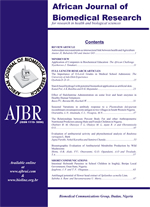
|
African Journal of Biomedical Research
Ibadan Biomedical Communications Group
ISSN: 1119-5096
Vol. 6, No. 2, 2003, pp. 95-100
|
 Bioline Code: md03018
Bioline Code: md03018
Full paper language: English
Document type: Research Article
Document available free of charge
|
|
|
African Journal of Biomedical Research, Vol. 6, No. 2, 2003, pp. 95-100
| en |
THE EFFECT OF MEMBRANE DIFFUSION POTENTIAL CHANGE ON ANIONIC DRUGS INDOMETHACIN AND BARBITONE INDUCED HUMAN RED BLOOD CELL SHAPE CHANGE AND ON CELLULAR UPTAKE OF DRUGS.
NWAFOR A. AND COAKLEY W. T.
Abstract
The effect of membrane potential change on anionic drugs Indomethacin and barbitone induced human erythrocyte shape change and red cell uptake of drug has been studied using microscopy and spectrophotometry techniques respectively. The membrane potential was changed by reducing the extracellular chloride concentration while maintaining the ionic strength and the osmolarity of the cell suspending solutions constant. At indomethacin and barbitone concentractions necessary to cause marked cell crenation membrane diffusion potential change from - 7.1 mV to 16 . 4niV, led to the reversal of the shape changing properly of the drugs to cup formers. The cellular uptake of drug increased with increasing membrane potential. The membrane potential dependent shape change was also reversible on revering the membrane potential. The results suggest that cellular uptake of drug and drug induced cell shape change was strongly dependent on changes in the extracellular chloride concentration which alter the potential across the erythrocyte membrane. These findings may be of medical significance such as in the design of drugs, for example, for sickle cell diseases, malarial diseases, since knowledge of the concentration and location of the molecules with respect to the membrane surface is required.
Keywords
Membrane potential anionic drugs, uptake, human erythrocyte.
|
| |
© Copyright 2003 - Ibadan Biomedical Communications Group
|
|
